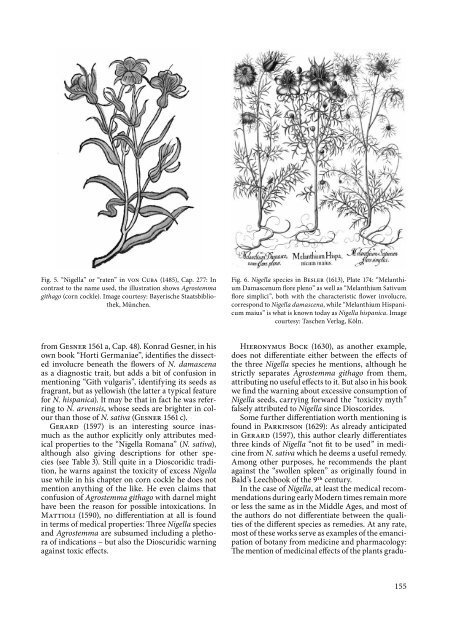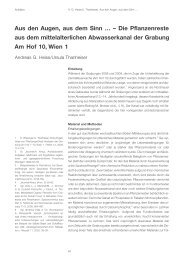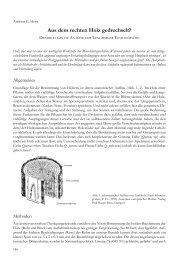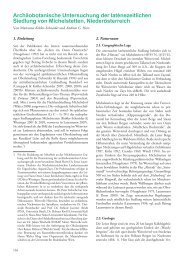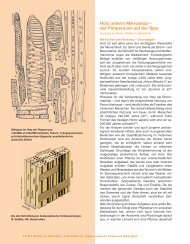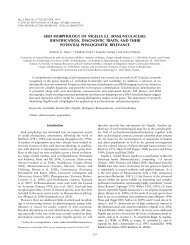View - erbsenzaehler.at
View - erbsenzaehler.at
View - erbsenzaehler.at
Create successful ePaper yourself
Turn your PDF publications into a flip-book with our unique Google optimized e-Paper software.
Fig. 5. “Nigella” or “r<strong>at</strong>en” in von Cuba (1485), Cap. 277: In<br />
contrast to the name used, the illustr<strong>at</strong>ion shows Agrostemma<br />
githago (corn cockle). Image courtesy: Bayerische Sta<strong>at</strong>sbibliothek,<br />
München.<br />
Fig. 6. Nigella species in Besler (1613), Pl<strong>at</strong>e 174: “Melanthium<br />
Damascenum flore pleno” as well as “Melanthium S<strong>at</strong>ivum<br />
flore simplici”, both with the characteristic flower involucre,<br />
correspond to Nigella damascena, while “Melanthium Hispanicum<br />
maius” is wh<strong>at</strong> is known today as Nigella hispanica. Image<br />
courtesy: Taschen Verlag, Köln.<br />
from Gesner 1561 a, Cap. 48). Konrad Gesner, in his<br />
own book “Horti Germaniae”, identifies the dissected<br />
involucre bene<strong>at</strong>h the flowers of N. damascena<br />
as a diagnostic trait, but adds a bit of confusion in<br />
mentioning “Gith vulgaris”, identifying its seeds as<br />
fragrant, but as yellowish (the l<strong>at</strong>ter a typical fe<strong>at</strong>ure<br />
for N. hispanica). It may be th<strong>at</strong> in fact he was referring<br />
to N. arvensis, whose seeds are brighter in colour<br />
than those of N. s<strong>at</strong>iva (Gesner 1561 c).<br />
Gerard (1597) is an interesting source inasmuch<br />
as the author explicitly only <strong>at</strong>tributes medical<br />
properties to the “Nigella Romana” (N. s<strong>at</strong>iva),<br />
although also giving descriptions for other species<br />
(see Table 3). Still quite in a Dioscoridic tradition,<br />
he warns against the toxicity of excess Nigella<br />
use while in his chapter on corn cockle he does not<br />
mention anything of the like. He even claims th<strong>at</strong><br />
confusion of Agrostemma githago with darnel might<br />
have been the reason for possible intoxic<strong>at</strong>ions. In<br />
M<strong>at</strong>tioli (1590), no differenti<strong>at</strong>ion <strong>at</strong> all is found<br />
in terms of medical properties: Three Nigella species<br />
and Agrostemma are subsumed including a plethora<br />
of indic<strong>at</strong>ions – but also the Dioscuridic warning<br />
against toxic effects.<br />
Hieronymus Bock (1630), as another example,<br />
does not differenti<strong>at</strong>e either between the effects of<br />
the three Nigella species he mentions, although he<br />
strictly separ<strong>at</strong>es Agrostemma githago from them,<br />
<strong>at</strong>tributing no useful effects to it. But also in his book<br />
we find the warning about excessive consumption of<br />
Nigella seeds, carrying forward the “toxicity myth”<br />
falsely <strong>at</strong>tributed to Nigella since Dioscorides.<br />
Some further differenti<strong>at</strong>ion worth mentioning is<br />
found in Parkinson (1629): As already anticip<strong>at</strong>ed<br />
in Gerard (1597), this author clearly differenti<strong>at</strong>es<br />
three kinds of Nigella “not fit to be used” in medicine<br />
from N. s<strong>at</strong>iva which he deems a useful remedy.<br />
Among other purposes, he recommends the plant<br />
against the “swollen spleen” as originally found in<br />
Bald’s Leechbook of the 9th century.<br />
In the case of Nigella, <strong>at</strong> least the medical recommend<strong>at</strong>ions<br />
during early Modern times remain more<br />
or less the same as in the Middle Ages, and most of<br />
the authors do not differenti<strong>at</strong>e between the qualities<br />
of the different species as remedies. At any r<strong>at</strong>e,<br />
most of these works serve as examples of the emancip<strong>at</strong>ion<br />
of botany from medicine and pharmacology:<br />
The mention of medicinal effects of the plants gradu-<br />
155


